Dissociative Identity Disorder
- 格式:docx
- 大小:17.65 KB
- 文档页数:2
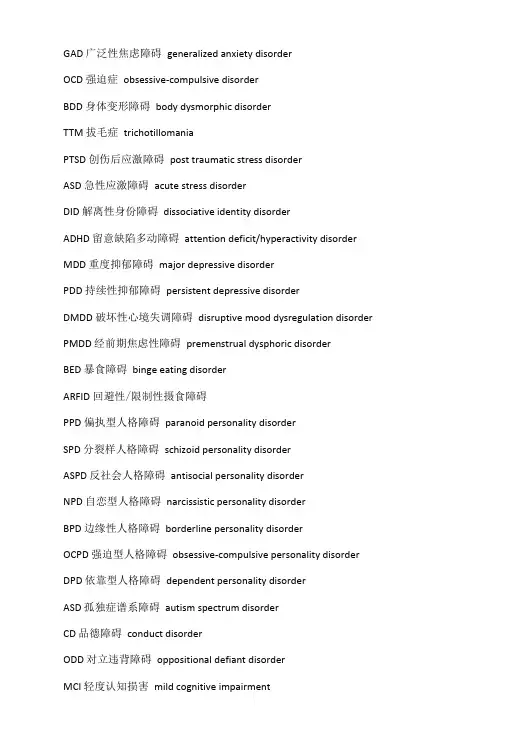
GAD 广泛性焦虑障碍generalized anxiety disorderOCD 强迫症obsessive-compulsive disorderBDD 身体变形障碍body dysmorphic disorderTTM 拔毛症trichotillomaniaPTSD 创伤后应激障碍post traumatic stress disorderASD 急性应激障碍acute stress disorderDID 解离性身份障碍dissociative identity disorderADHD 留意缺陷多动障碍attention deficit/hyperactivity disorder MDD 重度抑郁障碍major depressive disorderPDD 持续性抑郁障碍persistent depressive disorderDMDD 破坏性心境失调障碍disruptive mood dysregulation disorder PMDD 经前期焦虑性障碍premenstrual dysphoric disorderBED 暴食障碍binge eating disorderARFID回避性/限制性摄食障碍PPD 偏执型人格障碍paranoid personality disorderSPD 分裂样人格障碍schizoid personality disorderASPD 反社会人格障碍antisocial personality disorderNPD 自恋型人格障碍narcissistic personality disorderBPD 边缘性人格障碍borderline personality disorderOCPD 强迫型人格障碍obsessive-compulsive personality disorder DPD 依靠型人格障碍dependent personality disorderASD 孤独症谱系障碍autism spectrum disorderCD 品德障碍conduct disorderODD 对立违背障碍oppositional defiant disorderMCI 轻度认知损害mild cognitive impairmentCBT 认知-行为治疗cognitive-behavioral therapyIPSRT 人际和社会节奏治疗interpersonal and social rhythm therapy ECT 电休克治疗electroconvulsive therapy。
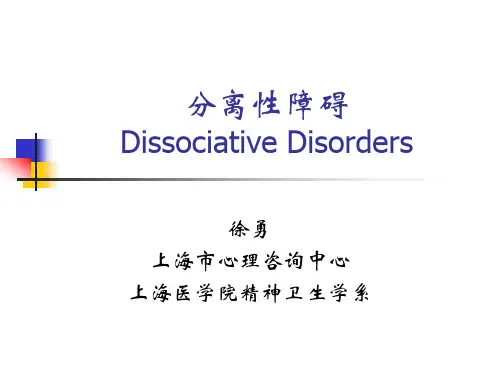
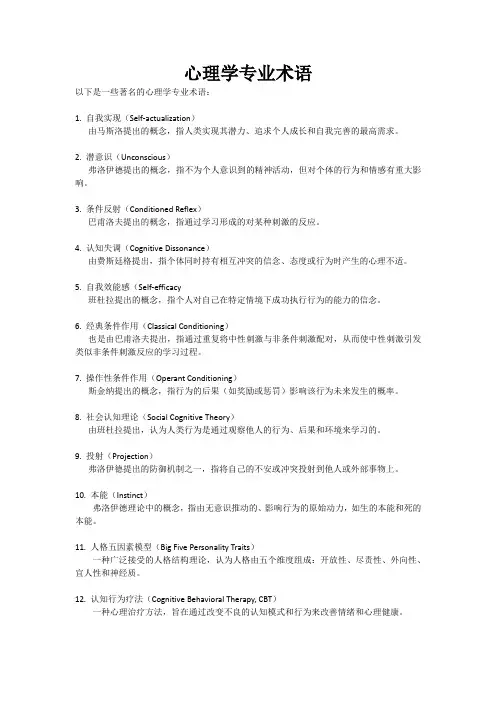
心理学专业术语以下是一些著名的心理学专业术语:1. 自我实现(Self-actualization)由马斯洛提出的概念,指人类实现其潜力、追求个人成长和自我完善的最高需求。
2. 潜意识(Unconscious)弗洛伊德提出的概念,指不为个人意识到的精神活动,但对个体的行为和情感有重大影响。
3. 条件反射(Conditioned Reflex)巴甫洛夫提出的概念,指通过学习形成的对某种刺激的反应。
4. 认知失调(Cognitive Dissonance)由费斯廷格提出,指个体同时持有相互冲突的信念、态度或行为时产生的心理不适。
5. 自我效能感(Self-efficacy班杜拉提出的概念,指个人对自己在特定情境下成功执行行为的能力的信念。
6. 经典条件作用(Classical Conditioning)也是由巴甫洛夫提出,指通过重复将中性刺激与非条件刺激配对,从而使中性刺激引发类似非条件刺激反应的学习过程。
7. 操作性条件作用(Operant Conditioning)斯金纳提出的概念,指行为的后果(如奖励或惩罚)影响该行为未来发生的概率。
8. 社会认知理论(Social Cognitive Theory)由班杜拉提出,认为人类行为是通过观察他人的行为、后果和环境来学习的。
9. 投射(Projection)弗洛伊德提出的防御机制之一,指将自己的不安或冲突投射到他人或外部事物上。
10. 本能(Instinct)弗洛伊德理论中的概念,指由无意识推动的、影响行为的原始动力,如生的本能和死的本能。
11. 人格五因素模型(Big Five Personality Traits)一种广泛接受的人格结构理论,认为人格由五个维度组成:开放性、尽责性、外向性、宜人性和神经质。
12. 认知行为疗法(Cognitive Behavioral Therapy, CBT)一种心理治疗方法,旨在通过改变不良的认知模式和行为来改善情绪和心理健康。
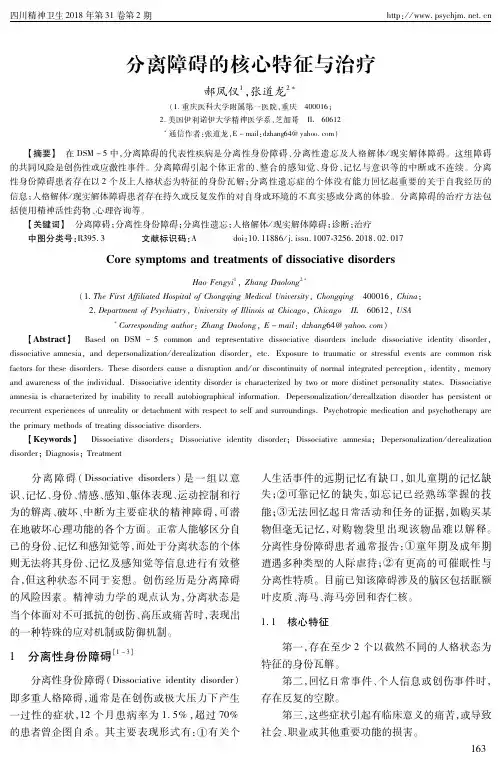
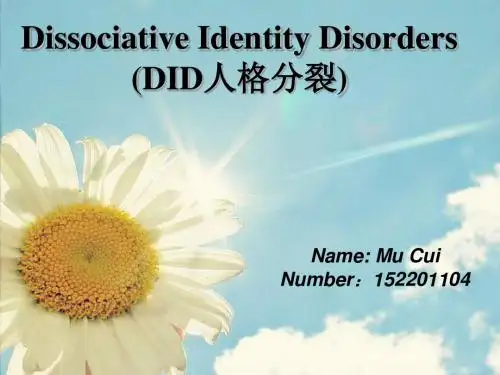

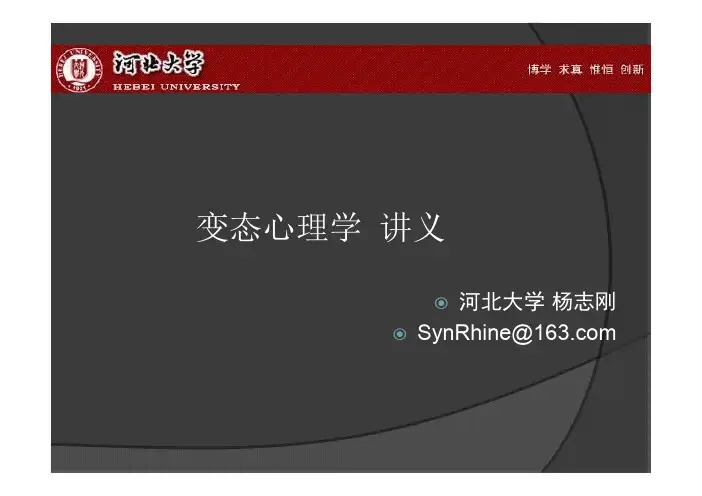
变态心理学讲义河北大学杨志刚SynRhine@变态心理学讲义第七章躯体形式障碍和分离障碍(Somatoform and Dissociative Disorders)躯体形式及分离障碍一、概述二、躯体形式障碍(somatoform disorder)y疑病症(hypochondriasis)y躯体化障碍(somatization disorder)y转换性障碍(conversion disorder)y疼痛障碍(pain disorder)y身体畸形障碍(body dysmorphic disorder)三、分离障碍(dissociative disorder)y人格解体障碍(depersonalization disorder)y分离性遗忘(dissociative amnesia)y分离性漫游(dissociative fugue)y分离性身份障碍(dissociative identity disorder, DID)Breuer’s case of Anna O.anddisorder Abnormal psychology头痛,脖子和肢体麻痹,严重的咳嗽,吞咽和说话困难。
但没有可查的物理原因。
4概述癔症的历史y癔症(Hysteria),亦译作歇斯底里y中世纪认为癔症是由于妖魔作怪、精灵附体.y18世纪认为癔症起源于神经系统和大脑的异常y19世纪末,夏柯()认为是中枢神经系统的生理障碍造成的,而弗洛伊德则认为癔症是无意识的动机冲突所致y自1980年,DSM-III取消了神经症(neurosis)这个疾病名称。
同时取消了“癔症”这个疾病单元,改为转换和分离障碍躯体形式障碍和分离性障碍的比较相似之处y都找不出真正的器质性损伤,只是在意识层面上存在障碍。
y两类障碍都模拟了真正的神经病性障碍的形式。
y两类障碍都可以看作是“神经症”。
差异y分离性障碍表现为高层次认知功能的障碍y转换性障碍表现的是感觉、运动功能的障碍。
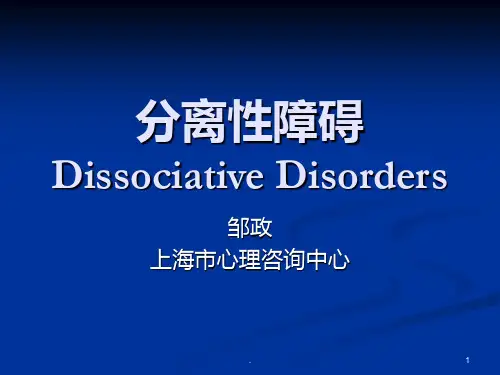

多重人格障碍的形成及治疗?*导读:多重人格正确学名应该是解离性身份障碍(dissociativeidentitydisorder),又叫人格分裂通俗的讲,多重人格障碍就是在个体内存在多个不一样的人格不一样的人格在不一样的同的时间或者条件下占据不一样的地位,不同人格之间是独立的,并形成一个完整的个体……多重人格正确学名应该是解离性身份障碍(dissociative identity disorder),又叫人格分裂,通俗的讲,多重人格障碍就是在个体内存在多个不一样的人格不一样的人格在不一样的同的时间或者条件下占据不一样的地位,不同人格之间是独立的,并形成一个完整的个体*1.多重人格障碍是如何形成的?多重人格障碍是成长过程中的一些人和事在不同的阶段,一次或多次强烈的刺激下导致个体的人格分裂现象。
很多事是可以通过治疗康复的,另外还与不同的人给他的不同压力,每个人与他的利益关系,复杂的社会现实相关,还有些原因就是经受了许多的打击有时候是毁灭性的,又没有向别人倾诉,年纪大了就容易造成这种病*2.多重人格障碍有哪些特征?1. 每种人格都有自己的的年龄层,每种人格都有自己的的价值观。
每一种人格都是完整的,有自己的记忆、行动、爱好,可以独立地与他人处。
2. 有些人格知道另一些人格的存在,有一些则是完全独立的。
在一些时段内,会有一两个人格处于“值班”状态,3. 不一样的人格之间的替换过程通常是快的,但别人是很难辨别为什么他变得这么快,也因此常被误以为在装病。
4. 病人患有失忆症;或者感到日子过得很快,常常不记得自己做过的事情。
5.病人易被催眠,常常收到别人话语的暗示,即使别人并不是这样想的。
6. 但奇怪的是在接受治疗检查时,却发现患者和常人无异;就算是病人患的失忆症也不是一下子就能够看出来,要经过长时间的观察。
*3.多重人格障碍怎么治疗?对多重人格的治疗是漫长的过程,最好的是让这些人格逐渐的融合在一起,成为一个人。

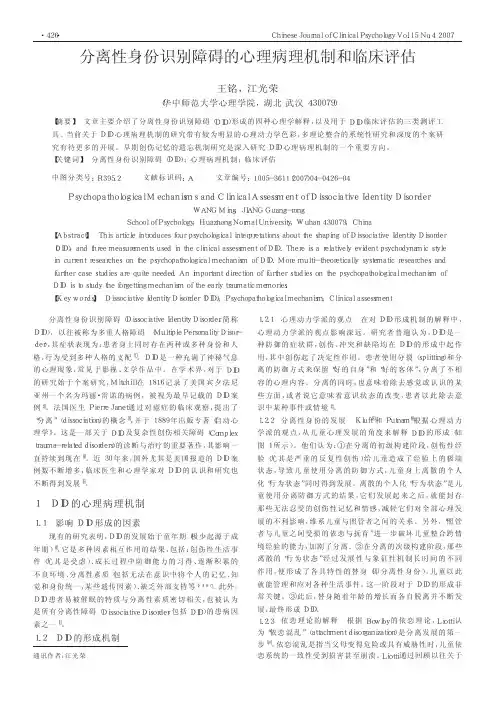
分离性身份识别障碍的心理病理机制和临床评估王铭,江光荣(华中师范大学心理学院,湖北武汉430079)【摘要】文章主要介绍了分离性身份识别障碍(DID)形成的四种心理学解释,以及用于DID临床评估的三类测评工具。
当前关于DID心理病理机制的研究带有较为明显的心理动力学色彩,多理论整合的系统性研究和深度的个案研究有待更多的开展。
早期创伤记忆的遗忘机制研究是深入研究DID心理病理机制的一个重要方向。
【关键词】分离性身份识别障碍(DID);心理病理机制;临床评估中图分类号:R395.2文献标识码:A文章编号:1005-3611(2007)04-0426-04PsychopathologicalMechanismsandClinicalAssessmentofDissociativeIdentityDisorderWANGMing,JIANGGuang-rongSchoolofPsychology,HuazhongNormalUniversity,Wuhan430079,China【Abstract】ThisarticleintroducesfourpsychologicalinterpretationsabouttheshapingofDissociativeIdentityDisorder(DID),andthreemeasurementsusedintheclinicalassessmentofDID.ThereisarelativelyevidentpsychodynamicstyleincurrentresearchesonthepsychopathologicalmechanismofDID.Moremulti-theoreticallysystematicresearchesandfurthercasestudiesarequiteneeded.AnimportantdirectionoffurtherstudiesonthepsychopathologicalmechanismofDIDistostudytheforgettingmechanismoftheearlytraumaticmemories.【Keywords】DissociativeIdentityDisorder(DID);Psychopathologicalmechanism;Clinicalassessment分离性身份识别障碍(DissociativeIdentityDisorder,简称DID),以往被称为多重人格障碍(MultiplePersonalityDisor-der),其症状表现为:患者身上同时存在两种或多种身份和人格,行为受到多种人格的支配[1]。
Dissociative Identity Disorder (Multiple PersonalityDisorder)Dissociative identity disorder (previously known as multiple personality disorder) is thought to be an effect of severe trauma during early childhood, usually extreme, repetitive physical, sexual, or emotional abuse.分离性身份识别障碍(以前称为多重人格障碍)被认为是在儿童早期,通常是在极端的,重复的身体,性或精神虐待过程中受到严重创伤的影响。
Most of us have experienced mild dissociation, which is like daydreaming or getting lost in the moment while working on a project. However, dissociative identity disorder is a severe form of dissociation, a mental process which produces a lack of connection in a person's thoughts, memories, feelings, actions, or sense of identity. Dissociative identity disorder is thought to stem from trauma experienced by the person with the disorder. The dissociative aspect is thought to be a coping mechanism -- the person literally dissociates himself from a situation or experience that's too violent, traumatic, or painful to assimilate with his conscious self.我们中的大多数人都经历过轻微的分离,这就像在一个项目工作时做白日梦或是迷失了方向。
然而,分离性身份障碍是一种严重的解离,是一个人的思想、记忆、感觉、行动,或者认同感缺乏产生连接的心理过程。
分离性身份识别障碍被认为是由被有不正当行为的人的创伤经历引起的。
游离的方面被认为是一种应对机制——人在太暴力,受伤,或痛苦的情况或经历时确实会有自我意识地分解同化他们自己。
Dissociative identity disorder is characterized by the presence of two or more distinct or split identities or personality states that continually have power over the person's behavior. With dissociative identity disorder, there's also an inability to recall key personal information that is toofar-reaching to be explained as mere forgetfulness. With dissociative identity disorder, there are also highly distinct memory variations, which fluctuate with the person's split personality.多重人格障碍的特点是存在两个或两个以上的不同或分裂的身份或人格个性,不断地支配人的行为。
患有分离性身份识别障碍,无法回忆起深远的关键个人信息仅仅被解释为健忘。
患有分离性身份识别障碍,也有非常明显的人格分裂波动的记忆变化。
The "alters" or different identities have their own age, sex, or race. Each has his or her own postures, gestures, and distinct way of talking. Sometimes the alters are imaginary people; sometimes they are animals. As each personality reveals itself and controls the individuals' behavior and thoughts, it's called "switching." Switching can take seconds to minutes to days. When under hypnosis, the person's different "alters" or identities may be very responsive to the therapist's requests.这些“改变”或不同的身份有自己的年龄,性别,或种族。
每个都有他或她自己的姿势,手势和不同的说话方式。
有时候,改变是虚构的人,有时他们是动物。
当每一个人的个性都显示出来,并且控制着个体的行为和思想,它被称为“转换”。
切换可以用秒到几分钟的时间。
在催眠状态下,人的不同的“改变”或身份对治疗师的要求可能会非常地积极回应。
While the causes of dissociative identity disorder are still vague, research indicates that it is likely a psychological response to interpersonal and environmental stresses, particularly during early childhood years when emotional neglect or abuse may interfere with personality development.As many as 99% of individuals who develop dissociative disorders have recognized personal histories of recurring, overpowering, and oftenlife-threatening disturbances at a sensitive developmental stage of childhood (usually before age 9). Dissociation may also happen when there has been insistent neglect or emotional abuse, even when there has been no overt physical or sexual abuse. Findings show that in families where parents are frightening and unpredictable, the children may become dissociative.尽管分离性身份障碍的原因仍然是模糊的,但研究表明,它很可能是一个应对人际关系和环境压力的心理反应,特别是在早期的童年时期情感受到忽视或滥用的时候可能影响了人格的发展。
我们已经认识到99%的在童年发育敏感期(通常是9岁之前)有个人经历的反复的,无法抵抗的,并且经常危及生命的障碍的人会患上分离性障碍。
解离也可能发生在出现了明显的忽视或精神虐待的时候,即使没有明显的身体或性虐待。
研究结果表明,在父母是可怕的和变化莫测的家庭里的孩子可能患上游离。
While there's no "cure" for dissociative identity disorder, long-term treatment can be helpful, if the patient stays committed. Effective treatment includes talk therapy or psychotherapy, hypnotherapy, and adjunctive therapies such as art or movement therapy. There are noestablished medication treatments for dissociative identity disorder, making psychologically-based approaches the mainstay of therapy.Because the symptoms of dissociative disorders often occur with other disorders, such as anxiety and depression, medicines to treat thoseco-occurring problems, if present, are sometimes used in addition to psychotherapy.虽然没有对分离性身份识别障碍的“治愈”,但如果病人能坚持,长期治疗也是有帮助的。
有效的治疗包括谈话疗法或心理疗法、催眠疗法、辅助疗法如艺术或运动疗法。
对于分离性身份障碍是没有确定的药物治疗的,这使心理基础方法成为主要的治疗方法。
由于分离性障碍的症状常伴有其他疾病,如焦虑和抑郁,如果有,除了心理治疗外,有时可用药物来治疗那些共同存在的问题。
Respond:1.What Is Dissociative Identity Disorder?什么是分离性身份识别障碍?()2.What Are the Symptoms of Dissociative Identity Disorder? 分离性身份障碍的症状是什么?()3.Who Gets Dissociative Identity Disorder? 谁会患上分离性身份障碍?()4.What's the Recommended Treatment Plan for Dissociative Identity Disorder? 对于分离性身份障碍推荐的治疗方案是什么?()答:Effective treatment includes talk therapy or psychotherapy, hypnotherapy, and adjunctive therapies such as art or movement therapy. Here are no established medication treatments for dissociative identity disorder, making psychologically-based approaches the mainstay of therapy.。